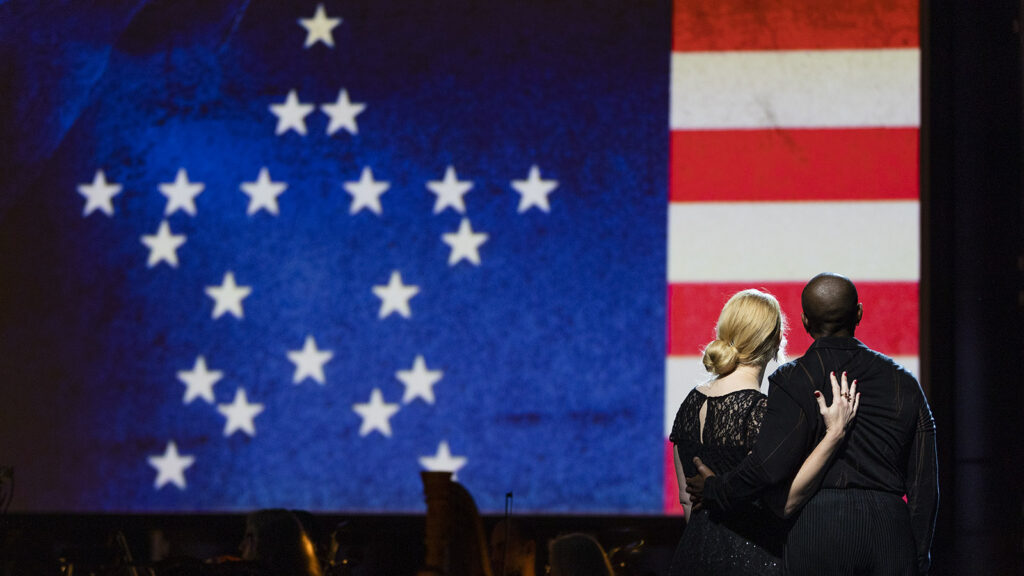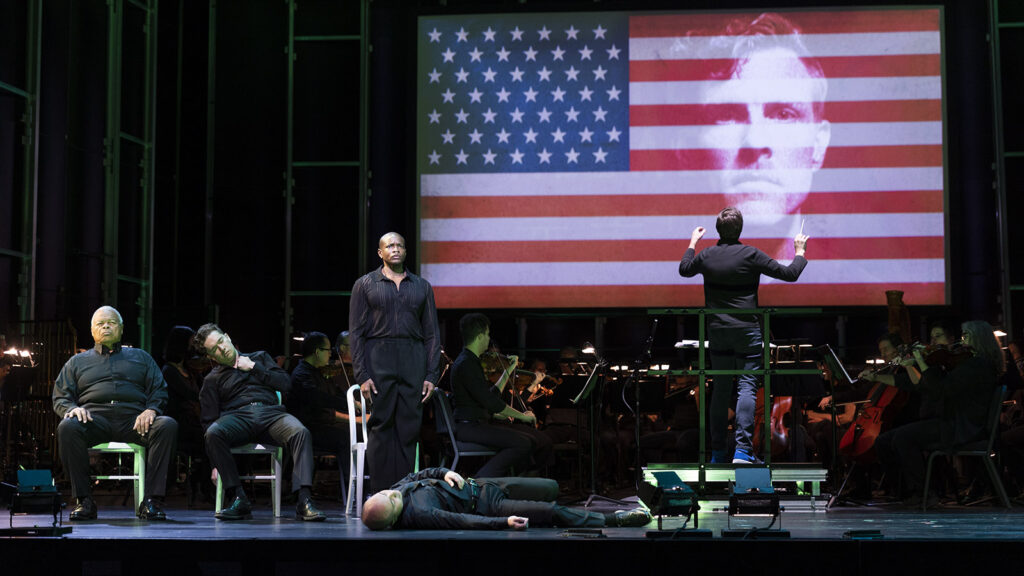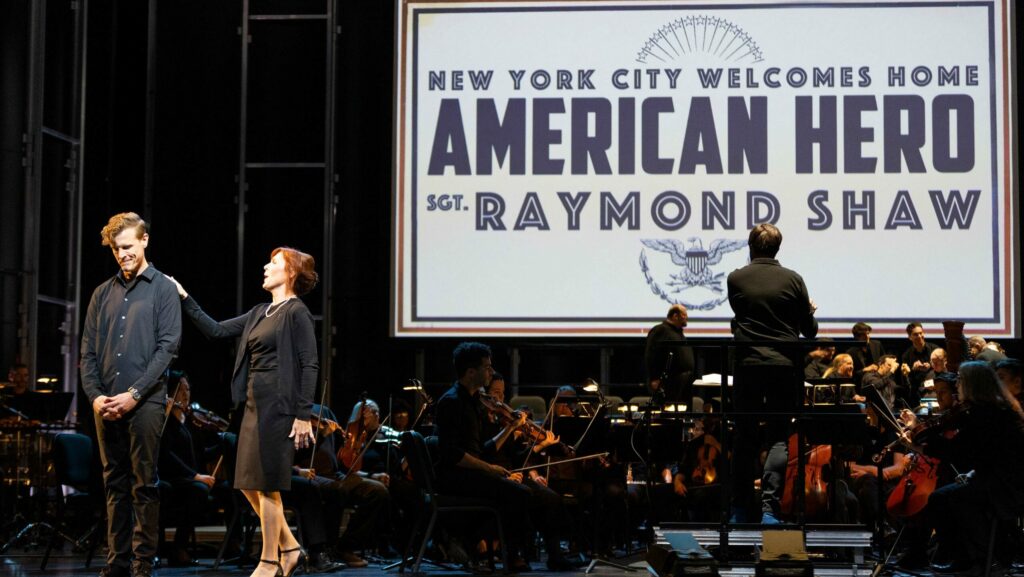
While exploring political intrigue and psychological manipulation in Condon’s novel, Pulitzer Prize-winning creators Puts and Campbell emphasized the fragility of identity, which resonated strongly with contemporary concerns. For instance, Puts contrasted the huge, full-throated brass chords, evoking political conspiracy, with a single note played by a single instrument to describe each character’s inner voice. The opera itself opens with a simple, repeated note that immediately set a mood of suspense and foreboding. This motif, which is later linked to the characters of Eleanor Iselin and Queen Diamond, was a powerful example of how Puts uses musical transformation to evoke changing emotional landscapes. Additionally, Campbell depicts Eleanor, who urges her son Raymond Shaw to commit an assassination, not as a traditional villain but as a woman who is a product of the system she inhabits.
To bring Puts and Campbell’s vision to life, director Alison Moritz’s semi-staged production aimed to create “a brand new living memory of this story” with performers dressed in black rather than elaborate costumes—there were not even any costumes in the costume party scene.
This bold choice placed the emotional and psychological landscape of the characters at the forefront, encouraging the audience to focus on the intricate characterizations and powerful musical expressions rather than visual spectacle (except for projections). During that same “costume” party scene, the musical shift from Eleanor’s singing to a bluegrass tune, a delightful touch, came through with clarity, enhancing a contrast between a larger political context and an individual’s fragility. Performing the opera semi-staged was a wise decision that allowed the its emotional depth to shine through, aligning well with the theme of individuals’ struggling against larger political forces.
A particularly notable aspect of this production was the opportunity it provided for numerous role debuts. Among the main characters, Mark Diamond as Sergeant Raymond Shaw, Mary Dunleavy as Eleanor Iselin, and Frederick Ballentine as Captain Ben Marco stood out in their respective roles, each offering vivid interpretations that added layers of complexity to the opera’s already anxious atmosphere.
Diamond’s voice effortlessly navigated the emotional range required for the character—from the aria recalling the lovely summer day when he first met Jocelyn Jordan, which he delivered with a soft, warm tone, to the tension-filled moments of the opera’s darker themes. Diamond’s use of his head voice was particularly impressive, capturing the fragility and psychological turmoil of Raymond as he grappled with the brainwashing imposed upon him. His performance of the aria“Lies” was an intense, gut-wrenching moment that resonated with emotional depth, underscoring Raymond’s tragic entanglement in the political machinations that controlled his life.
Dunleavy’s interpretation of Eleanor—someone who is ambitious but also trapped by the forces around her—was highly captivating, especially for her pristine high notes. On one hand, in her “It’s the Girl,” Dunleavy skillfully expressed Eleanor’s ambition with a strong and solid tone, and on the other hand, she expressed Eleanor’s vulnerability with a quietly trembling one after commanding the final assassination from Raymond.
Ballentine brought a compelling range of characteristics to Captain Ben Marco. Ballentine captured Marco’s earnest vulnerability early in the opera with a rich range of facial expressions and remarkable acting, particularly in the scene where he relived the horrors of his past through nightmares. His trembling voice, nearly on the verge of tears, was utterly captivating as he recounted the deaths of his two comrades—Ed Mavole and Bobby Lembeck—at Raymond’s hands. In a lighter moment, when Marco meets Rosie, Ballentine’s playful, almost charming interpretation of the character offered a contrast to the grimness surrounding him, giving the audience a fleeting moment of reprieve.
At the opera’s conclusion, when Marco discovers that Raymond’s trigger—what pushes him into a state of unquestioning obedience—is Queen Diamond, Marco directs Raymond to shoot Johnny with one hand, Eleanor with the other, and finally, to turn the gun on himself. Amidst the sorrow of Raymond’s tragic fate, Ballentine masterfully conveyed the complex emotions of a man torn between the anguish of his duty and the necessity of stopping Eleanor and Johnny Iselin for the greater good. His tone captured the internal conflict, balancing both the personal heartbreak and the cold, pragmatic decision to save the larger cause.
Donnie Ray Albert, as Andrew Hanley, left a brief yet profound appearance in the scene where he conveys Hanley’s shared nightmares with Marco through a letter, pulling the sound from deep within himself to vividly express Hanley’s inner torment. Kyle Albertson as Johnny was particularly impressive in the press conference scene, where he firmly stated that 207 communists were within the Department of Defense with a resonant, striking tone. Rachel Blaustein as Jocelyn added emotional gravity to the production, offering a deeply sorrowful tone during the “We Are Safe” duet with Raymond. Jamie Van Eyck as Rosie Chayney not only delivered a stable performance but also added a touch of charm to this tension-filled opera.
Music director Timothy Myers brilliantly realized Puts’s musical vision, with the music itself cleverly capturing the machinations, horror, and personal vulnerability brought on by political power.
One of the most striking moments came during the convention in Act II, where the intense, climactic choral brought a raw, terrifying energy to the opera. The sound of screaming in the aftermath of the assassination was masterfully expressed through the music, amplifying the horror of the moment and creating a palpable sense of fear. Myers skillfully led the musical direction with a deep understanding of how Puts’s music allows the audience to fully experience the opera, navigating through various sounds.
Austin Opera’s 2024 production of The Manchurian Candidate was a gripping, thought-provoking examination of power, manipulation, and identity that resonated with contemporary issues. With strong performances, bold direction, and an evocative musical score, the production once again proved the timeless relevance of Condon’s political thriller, making it a must-see for opera lovers and anyone interested in the intersection of politics and art.
Photos: Erich Schlegel







Comments